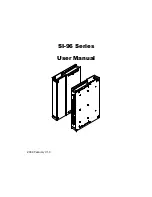
February 14, 2006
Installer Instructions for AlphaEclipse 3600 Signs (Form no. 9711-8028B)
5
3
Connect power
Observe safety precautions
Electrical installation guidelines
• Inspect all internal sign cabling for proper connection and seating.
• All power wiring must be from circuit breaker-protected lines.
• A two-pole disconnect device must be installed in the building wiring for each branch circuit supplying the sign.
• The sign must be properly grounded according to the applicable codes (for example, NEC Article 250 and 600, and IEEE
1100-1999).
• Run separate conduits for signal wires (for example, RS232, RS485) and for power wires. However, fiber optic wire may be
run in the same conduit with power wires.
• This sign should
not
be connected to a ground fault interrupt (GFI) circuit.
• All electrical connections must be watertight.
• Use minimum 80° C copper wire only.
Utiliser uniquement un fil en cuivre pouvant supporter 80° C minimum.
• Torque terminals to a minimum of 7 in/lbs and a maximum of 10 in/lbs.
Serrer les bornes à 0,79 N/m minimum, mais pas à plus de 1,13 N/m.
Run power to the sign
Use the information from “Determine sign power requirements” on page 2.
NOTE:
Make sure two conduits are run to the sign: one for power and the other for communication wires. See
“Connect MASTER UNIT to messaging computer” on page 8.
Ground the sign
The sign must be properly grounded in order to provide the following three types of protection:
• Ground fault protection — The sign must be wired to provide a permanent, low impedance pathway to carry sign ground
fault current.
Earth grounding a sign through some type of ground rod bonded to the sign is not sufficient ground fault
protection.
• Lightning strike protection — A sign must be earth grounded either through an existing ground rod or separate ground
rod(s) bonded to the sign. See National Electrical Code (NEC) Article 250.32. A ground lug in the sign’s wireway is provided
for this purpose.
• Electronic equipment protection — A common cause for the failure of sensitive electronic equipment is the presence of
objectionable current on grounding or bonding paths. Likely causes for objectionable current are (1) errors in installation
wiring, (2) improper neutral-to-case bonds, and (3) equipment-grounding conductor used to carry neutral current.
NOTE: Though #3 is permitted by NEC Article 250.32(B)(2), Adaptive does
not
recommend this wiring method because it
creates a potentially hazardous situation.
Contact with high voltage
may cause death or serious
injury.
Always disconnect power to
unit prior to servicing.
Hazardous voltage.
WARNING
SM1000A
HIGH LEAKAGE
CURRENT.
COURANT DE
FUITE ELEVE.
Earth connection
essential before
connecting
supply.
Raccordement
a la terre
indispensable
avant le
raccordement
au reseau.
AVERTISSEMENT
WARNING
SM1009A






































